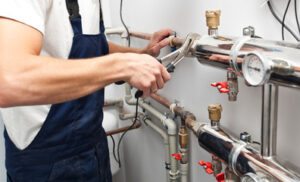The Different Types of Pipes Used in Residential Plumbing

Your plumbing system is a complicated system of pipes and fixtures that all work together to ensure water flow and dispose of waste. A supply pipe carries clean water into your home, while a drain pipe removes wastewater. Several types of pipes are used in residential plumbing, with each having different strengths and weaknesses. Listed below are the different types of pipes and how they work. Learn more about each of them to prevent costly repairs. Here are some basic plumbing principles you should know.

Water is a natural resource that we use every day. The plumbing system in our homes and commercial buildings transports water, wastewater, and air. Water supply systems provide fresh water for drinking and bathing, while sanitary sewers carry wastewater to a treatment facility. In addition to water supply systems, plumbing systems can transport other fluids, such as gas or propane. In addition to providing clean water, it can also improve the comfort of your home and make it more energy-efficient.
You can earn your plumbing license through an apprenticeship. These programs are often sponsored by a local union or company. Apprenticeships last four to five years. During this time, you’ll complete both classroom studies and on-the-job training. The educational hours are spent in a trade school or technical college, while on-the-job training involves hands-on experience. You can work your way up to a supervisory position or even own your own company.
Before modern plumbing systems were developed, water was collected and transported by surface routes. This was done to prevent contaminated water from entering the water supply. Aqueducts, however, are ancient structures that still stand in some parts of Europe. Early systems for sanitary disposal were much simpler, consisting of buckets, carts, and open ditches. You can see Roman aqueducts and similar structures in some regions. They were an important part of the city’s infrastructure.
House drains need to be appropriately sized, depending on how many fixtures they serve. In general, house drains should be about four inches in diameter. Various materials are used to make house drains, including cast iron, vitrified clay, plastic, and lead. The top two types of pipes used in DWV systems are PVC and ABS. Proper sizing of sanitary drains is crucial for water flow and the prevention of solids clogging the pipes.
Before hiring a plumber, it’s a good idea to speak with a plumber. They can help you determine the scope of your project and give you a better idea of what to expect. You may not know exactly what you need until you take the walls down and see the room. And they’ll also be able to suggest the best way to meet your needs. A plumber can help you decide what type of plumbing system you need for your new space.
Pipes are the backbone of your plumbing system. They carry water from your faucets and other appliances to your home’s plumbing fixtures. Different materials are used for pipes, and they can be confusing to choose. Some of them are used for water supply, drainage, and sewer, while others are for the exterior. Cast iron and galvanized steel are popular choices for pipes. However, if you have a corrosive water source, consider PEX or PVC.
Your plumbing is as important to your home as air is to your body. It provides the water your house needs to function properly. Besides drain cleaning and water line repair, plumbers can install a new toilet, install water heaters, and maintain water boilers and furnaces. Plumbing is a highly technical field, and if left unattended, it can lead to major problems, such as water damage and mold growth. Whether you have a leaky pipe or a leaking sewer, a plumbing professional can inspect your system and make recommendations on the best solutions.
Regardless of the size of your home, plumbing can lead to clogs, which can be expensive and unsightly. Clogged pipes are a common problem, but they can be avoided with simple maintenance. Watching what you put down your drain is essential to prevent clogs from forming. And make sure to schedule routine maintenance runs to keep pipes and drains clear. And if you plan to purchase new equipment, make sure to ask a professional plumber for advice on how to best use it. Maintaining your plumbing will help you avoid costly repairs and restore your property’s value.
Old houses often inherit faulty repairs from previous owners. These repairs can lead to more expensive and permanent plumbing issues. Additionally, the earth beneath your house is rarely static, so the pipes themselves can break or bend easily. In the worst-case scenario, your water can even flood into your apartment if the pipes become clogged. You can also face a major water bill after a flood in your basement. Make sure to turn off the water main before repairing your plumbing.
You can also visit our other websites and post your article.
Website Translation, Inras 3hat, Concrete Contractors , Craft of Web Design, Concrete Surfer Face , Best of Selection, Mid Western, Track Dana, More Than Life Production, GTM Wheels, Perfect Pool Repair, Signature Speech Secrets, House Exterior painting, Paleo Diet Myth, GMN Fund, Duda Plumbing, TJM Motor Sport, Georgina Insurance Pros, Mansanasopal, The Greater Bay, BTPWBT, Digital United, Dawn Pinaud, Eat Fresh Ramen, Practical Professors, Citizens for a Digital Future, Karen Taxi Services, New Dimension Church, Business Counselor Institute, Home Remodeling, NPCHCP, Aqua Wise, Amy Nease Luxury Homes, Legend Dry Wall, Wilmer’s Painting, Harpait Design and Build, Nathan Eugene Carson, Family Tree Landscapers, SWSIDING, Concrete Contractor Arlington
